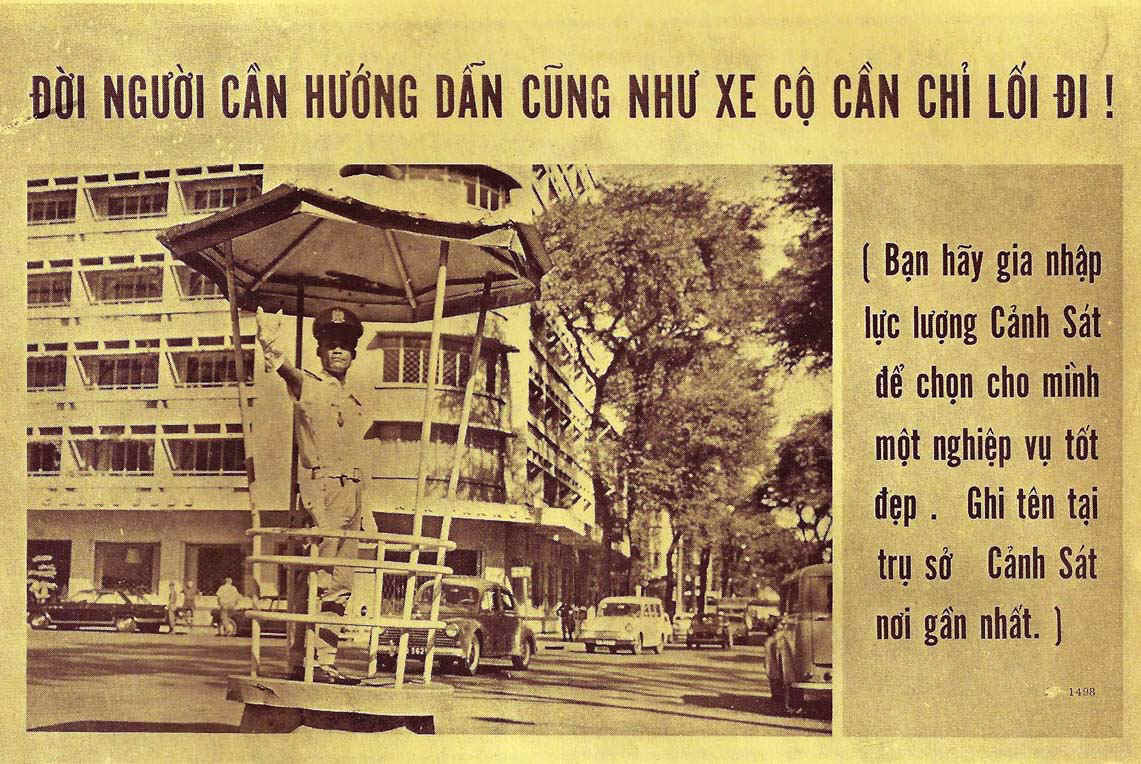This article will briefly look at the Government of (South) Vietnam’s national
police, the Canh Sat, sometimes called the “white mice” by American
troops because of their uniform white helmets and gloves.
My pal Sergeant Derrill de Heer was a member of the Australian 1st PSYOP Unit. He
mentioned the Vietnamese National police in his Master’s dissertation: Victoria
per Mentum: Psychological Operations conducted by the Australian Army in Phuoc Tuy
Province South Vietnam 1965 – 1971:
The National Police were often referred to by Vietnamese people and Allied forces
as ‘White Mice’ because of their white uniforms. National Police at all levels
within the province passed valuable intelligence to the Province Police Headquarters,
CORDS Team 89 and Australian Military Intelligence Liaison Officers (MILO), but
particularly in relation to those villagers on village “black lists.” A
“black list” contained details of known Viet Cong Suppliers (VCS), Viet Cong
Infrastructure personnel (VCI) and of families that had sons, daughters or other relatives
in the Viet Cong. In South Vietnamese society it was not an offence to supply family
members with food and clothing, but it was an offence to supply additional items of
assistance to the Viet Cong. Although the Police kept files on these people, they often
confessed to not having enough specific data on these known suspects to arrest them and
place them before the courts. The National Police had to be careful that reports from
people alleging that their neighbors gave assistance to the Viet Cong were substantial and
were not used to settle feuds between neighbors. False reporting did occur and was often
traced back to family feuds, commercial rivalry or the hope of being paid the reward money
offered by the government. Before any action was taken against a citizen there generally
had to be at least three independent reports on the person’s activities.
The armed wing of the National Police was the National Police Field Force (NPFF).
The NPFF were trained police and they operated and fulfilled the police mission in Viet
Cong contested and insecure areas. These forces were designed to operate with military
forces in population control operations and in operations against the underground Viet
Cong Infrastructure located in villages. They assisted military forces when conducting
cordon and searches of villages and hamlets, supporting major road block operations and by
conducting identity checks where there were large numbers of the local population. The
Australian PSYOP Unit and the Australian Task Force called on the National Police and the
National Police Force Field Force for assistance when conducting cordon and searches.
The average American soldier was no fan of the Vietnamese police force, and this is
easy to understand because on a weekend in Saigon the troops wanted liquor and women and a
good time while the police wanted to preserve the peace. There were a number of reported
incidents where the Vietnamese police stopped taxicabs with an American soldier and
Vietnamese female and demanded identification and a “cohabitation certificate.”
This was not a legal stop and the police were either guilty of harassment or looking for a
bribe by the American serviceman to let the taxicab proceed. In addition, because the
regime of South Vietnam was harsh, the police often used methods that Americans considered
brutal and fascist. It was a case of “culture shock” and both sides could make a
decent argument for their actions and beliefs.
The National Police were hampered by several problems. They had a poor image because
corruption has been a way of life to many of them, caused in part by low pay. National
Policemen received as little as $38 a month, although there were allowances for families.
Advancement was usually based on education and family rather than experience and this in
some cases led to lack of motivation.
Brian Downing was a young 18-year-old Specialist 4 assigned to a
small installation near Bien Hoa that was guarded by the People's
Self-Defense Force (PSDF), a South Vietnamese part-time volunteer village
level militia during the Vietnam War. He ran into the corruption mentioned
above when the Cahn Sat National police shook down the PSDFs for cash
payments. He informed his young Green Beret lieutenant who told him to hop
into his jeep. He adds:
We drove to the Cahn Sat Headquarters and marched unannounced into
the captain’s office. The lieutenant slammed his Colt Automatic Rifle
(CAR-15) on the captain’s desk, muzzle not quite aimed at the captain but
close enough to send the message. The Lieutenant yelled at him about the
shakedowns and demanded they stop. They did stop…
Because the Vietnamese Government was not always exactly democratic, the police had the
duty of seeing that unpopular laws were followed. In particular, they supported the regime
as ordered and did some dirty and difficult jobs such as searching for Vietnamese military
deserters and black marketers. On occasion they were the first responders at terrorist
attacks and bombings and found themselves fighting the Viet Cong guerrillas face to face.
As a result, the Viet Cong often targeted them for terror attacks, for instance, blowing
up a police headquarters or attacking checkpoints. More than 1,000 Vietnamese policemen
were killed every year by Communist Forces during the period of the U.S. military buildup.

Combat Intelligence Lessons
The
Confidential report Combat Intelligence Lessons was printed from
about 1968 to 1971 and adds:
The National Police: The entire National Police structure is
charged with maintaining civil law and order in rural and urban areas as
well as providing internal security against subversion and overthrow of the
duly constituted government. The National Police are not a military
organization and have neither the power nor the capability to control
VC-dominated areas. They cannot be expected to operate in areas where the
ARVN and Free World Military Armed Forces have not completed elimination of
main force and large VC/NVA units. Once an area has been cleared, however,
the police can begin to build a strong civil authority and control structure
necessary to support a functioning civil government at local level. To
perform this mission, the National Police are comprised of the following
four basic elements:
a. Uniformed Police (Canh Sat): The Uniformed Police are
responsible for population control as well as traffic control, a mission
like municipal police departments throughout the United States. Local
requirements determine the number of Uniformed Police personnel in each
province and district.
b. Special Police (Formerly the Police Special Branch): The Special
Police is the primary internal intelligence and security arm of the GVN and
may be roughly equated with the US Federal Bureau of Investigation. The
Special Police mission includes collection of intelligence on Viet Cong
Infrastructure (VCI), neutralization of VCI, monitoring political
activities, guarding VIPs, operation of Provincial Interrogation Centers
(PIC), and control of special national security projects.
c. National Police Field Force (NPFF): The NPFF is a paramilitary
force which operates in conjunction with the Special Police. The prime
mission of the NPFF is VCI elimination, prevention of VC resurgence, and
safeguarding the extension of other police into rural areas.
d. Provincial Reconnaissance Unit (PRU): The PRU is a special arm
of the National Police with a mission of destruction of VC/VCI. The PRU is
under the control of the Province Chief and, at his discretion, may be
utilized by Free World Military Armed Forces or District organizations.
JUSPAO Guidance Number 53, PSYOP Support of Pacification states that the U.S.
Government supported a Public Safety Program to train and equip a civil police force able
to cope effectively with civil disturbance, common crime and low level insurgency. The
U.S. provides training and material assistance through the CORDS Public Safety Division.
In the PSYOP field, CORDS personnel in the provinces assist the Government of Vietnam in
building a positive police image of public service and in explaining the need for police
control measures to protect the law-abiding population. Media support is furnished by
JUSPAO.
None of this should have been of any interest to U.S. forces that were fighting their
own war against the Viet Cong and North Vietnamese Army. However, as part of supporting
the Government of Vietnam and what we now call “nation building,” the United
States spent a great amount of effort and money to try and build a rapport between the
citizens of Vietnam and their police. In this article we will show some of the leaflets
and posters designed to convince the citizens of Vietnam that the police were their
friends and protectors and should be respected and emulated.
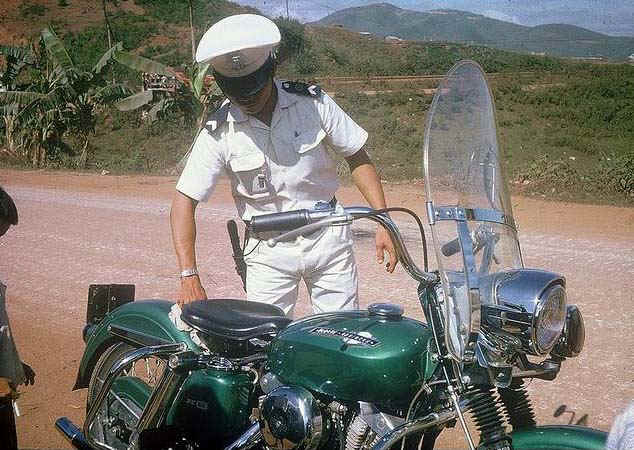
Vietnamese Motorcycle Policeman
South Vietnamese President Ngo Dinh Diem issued a decree in June of 1962 integrating
all then existing South Vietnamese police agencies into a single National Police Force who
answered to the Directorate General of National Police. The United States provided aid in
the form of weapons, supplies, training and advisory support-to the National Police of
South Vietnam, starting in 1954. Under the Public Safety program of the U.S. Agency for
International Development (USAID), the Vietnamese police force was converted from a civil
agency of 19,000 men in 1963 to a mammoth paramilitary organization of 120,000 men in
1973. The U.S. spent $155 million to support the police between 1967 and 1972. These
figures do not include CIA payments, or local currencies made available to the Government
of Vietnam through the Commodity Import Program and other U.S. accounts. These funds were
used to provide small arms, vehicles and helicopters, and other equipment to the
Vietnamese police, and to finance the team of over 200 U.S. Public Safety Advisors which
assisted the National Police Command in Saigon.
In its Fiscal 1972 Presentation to Congress, the Agency for International Development
reported that the function of the Public Safety program in South Vietnam was to help the
National Police “maintain law and order in urban and pacified rural areas, combat
smaller Viet Cong elements in areas of nominal government control, and deny resources to
the enemy.” However, witnesses testified that the Government of Vietnam has diverted
police resources from efforts to “maintain law and order” and “combat the
Viet Cong” to efforts to stifle and suppress the Vietnamese peace movement and other
non-communist opposition movements.
Specialist Fifth Class Ruben Rosario of the 29th General Support Group mentioned the
Vietnamese National police in a recent conversation:
I remember them well from watching the arrogant SOBs with amazement. I remember one
that could not have been more than 4'9", but he wore a huge “Dirty Harry”
.44 revolver, which he fired at a fleeing “draft dodger” who ran down a crowded
street. He hit the guy and managed to miss everyone else (I think). Then, he and an ARVN
Military Policeman picked up the unconscious and bleeding “draft dodger,” tossed
him into the back of a truck, and drove off.
The other thing that amazed me was the U.S. support they received. In the fall of
1968, I had occasion to visit the Port of Saigon, where a cargo ship was being off-loaded;
all of the cargo appeared to be vehicles for the White Mice; they were all painted the
green and white police colors. There were many M715s, the military version of the Kaiser
Jeep Corporation utility truck; we were still driving old M37s, when we could find a
utility truck. The most amazing sight in this shipment was about 50 brand new
Harley-Davidson police motorcycles, also green and white, and already with all of the
police gear on them. The biggest bike that I had ever seen a Vietnamese ride was something
along the lines of a Honda 90cc scooter.I can't imagine what they did with the big
Harleys.
I told Ruben that at one time Australia was thinking of supplying the Vietnamese police
with horses for a mounted squadron. I don’t know if that ever came to pass. Ruben
suspected they would have eaten the horses.
Specialist Fourth Class Paul Marling of Delta Company, 1st Battalion of the 12th
Cavalry told me about his only meeting with the National Police.
Our company had three Kit Carson Scouts, former Cambodians or Viet Cong who came
over to our side. We were out on a mission trying to chase down a North Vietnamese unit
and one of the Kit Carsons caught another of the scouts leaving notes and messages for the
enemy. We immediately aborted the mission and returned to our firebase Gibraltar. When we
arrived on the base there were about four White Mice waiting for us. They grabbed the guy;
put some handcuffs on him and the beat the shit out of him. They then all got into an ARVN
chopper and headed out. Suddenly, we saw a body fall from the chopper. The White Mice
claimed he jumped. It really did not matter; the end result would have been the same. They
were serious anti-Communists.
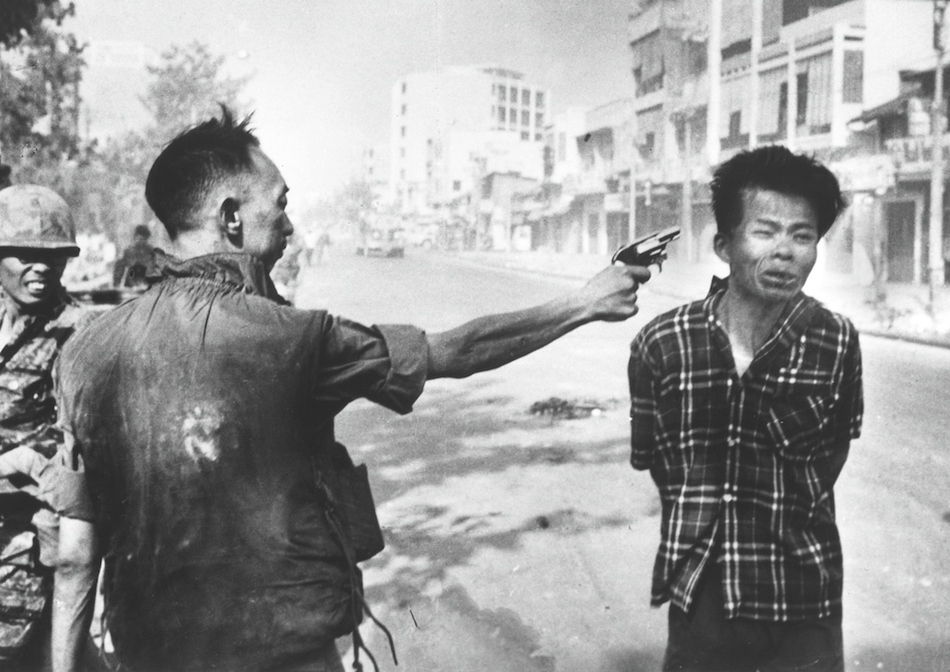
The Most Iconic Police Photograph of the Vietnam War
During the Tet attack of 1968 a distraught General Nguyen Ngoc Loan discovers that a
large number of his men and their families have been killed by the Viet Cong. Here he
takes matters into his own hands and executes a Viet Cong officer captured near the site
of a ditch holding thirty-four bound and shot bodies of police and their relatives, some
of whom were the families of Loan's deputy, and six of whom were his godchildren. Photo:
Eddie Adams
During the war the National Police Force was organized at national level with logistic
and administrative support from Saigon, but individual police departments under
operational control of province chiefs. The organization, known as the Directorate General
of National Police, was headed by sub-Brigadier General Nguyen Ngoc Loan. Loan headed a
staff of a deputy and six assistant directors for administration, personnel and training,
intelligence, operations, Field Forces and scientific police. All recruits go through an
intensive training program and members of the National Police Field Forces, the primary
arm of the force for its attack on the infrastructure, go to a specialized school. Advance
training for top-notch policemen was available at the International Police Academy in
Washington, D.C., and in several other foreign countries.
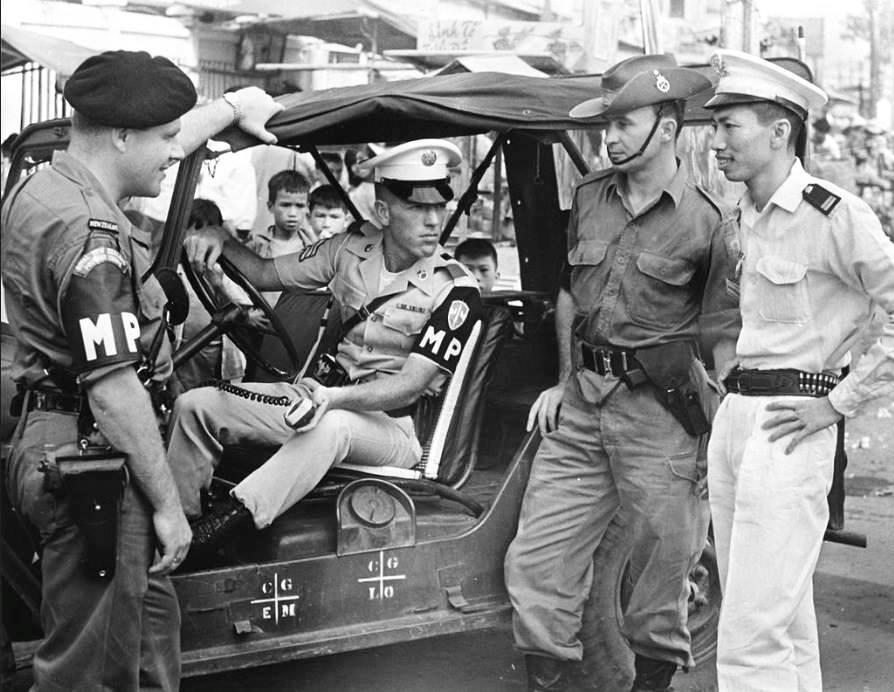
An international police patrol stops at a Saigon check point to await
radio orders. Left to right: Sergeant Val Petterson, New Zealand Army; Sergeant Richard D.
Green, U.S. Army; Corporal Eric Watkins, Australian Army; and Inspector Do Van Que of the
Saigon Municipal Police. Joint Jeep patrols such as this one operate in the Vietnamese
Capital to protect the interests of allied troops and simultaneously maintain constant
alert for Viet Cong terrorist activity. (Military Police of The Vietnam War)
Operations were often combined efforts with Military Policemen from US forces. For
example, patrol cars were often manned by an American MP, a Vietnamese military policeman
and two members of the National Police. A typical checkpoint might consist of an American
MP, a Vietnamese MP, a National Policeman and a National Policewoman.
THE LEAFLETS
As one might expect, there are dozens of leaflets and posters that depict the
Vietnamese National Police in a heroic pose with complimentary text. Since I intend this
to be a short article, I will illustrate just a few of these leaflets and the reader
should understand that there are many more. I selected those that I thought most
interesting from a pictorial or textual aspect. I note that almost all of the police
propaganda comes under JUSPAO theme 6, “Public Safety.”
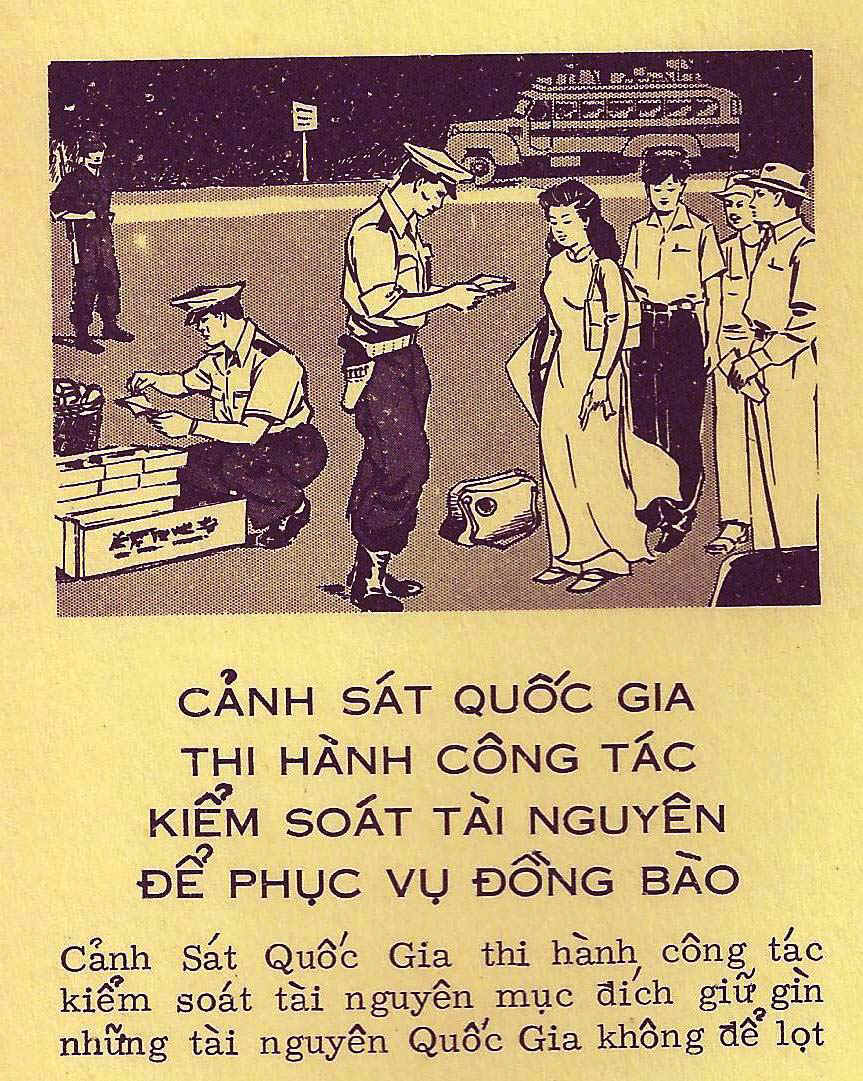
Leaflet 1537
One of the early propaganda products that depict the police is Joint United States
Public Affairs Office (JUSPAO) leaflet 1537. The theme is resource control. This was a
major effort of the police and had to do with checking all products being brought into
certain areas to search for illegal items, weapons, currency, and of course the occasional
Viet Cong of Vietnamese military deserter who might be identified when papers were
inspected. The leaflet depicts policemen checking items brought in by Vietnamese who just
disembarked from a bus. The text of this January 1967, 5 x 7-inch leaflet is in part:
THE NATIONAL POLICE SERVE THE PEOPLE BY RESOURCE CONTROL
Through their resource control teams the National Police protect the resources of
the country and pervert them from being diverted into the hands of the enemy. More and
more, the Viet Cong are being deprived of manpower, weapons, ammunition, and other
essentials of war. Their combat capabilities have been considerably weakened, and their
morale is being sapped. To properly perform their duties the Police inspect cars, buses,
boats, and other conveyances to prevent smuggling and infiltration. They check luggage,
parcels, baskets, and boxes for illicit goods. They also conduct house-to-house searches
in order to ferret out Viet Cong agents, hoodlums, and draft dodgers. If you encounter
minor difficulties because of inspections and searches please remember that the Police are
protecting you and serving the cause of the Government of Vietnam. Your cooperation is
needed.
There were 13 different 8 x 22-inch slogans prepared in May 1968 to support the
Resource control program. They are all coded 2617 and have such text as:
Resources control is designed to protect your lives and property.
Resources control prevents the Viet Cong from using our natural resources
Resources control interferes with Viet Cong infiltration and sabotage.
Other leaflets, such as 2125 actually told the people “What to do when you are at
a check point.” The text explains:
Keep in line and maintain order.
Present your identification card.
Have your packages or handbags ready for inspection.

Leaflet 2216
Many leaflets explain why there are checkpoints. For instance, 2126 and 2216 both ask
“Why are there check points?” The explanation:
To protect your families and your homes, the police set up check points to prevent
the Viet Cong from transporting bombs and other explosives to kill innocent people.
Check point are established in order to enforce law and order, so that you and other
innocent people can live in security.
The back adds:
Keep in line and maintain order when you get off and on a vehicle.
Present your ID card to the Police.
Get your packages or handbag ready for the Police to check.
Please follow these instructions in order to speed up the check.
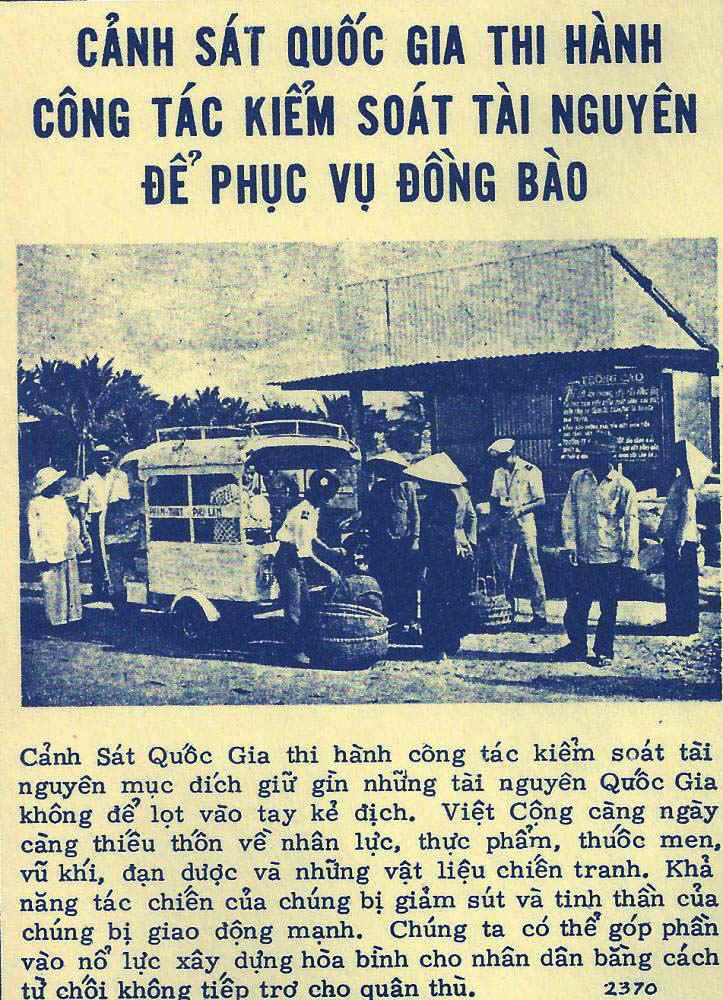
Leaflet 2370
This December 1967, 5 x 7-inch leaflet also is on the theme of resource control. It
goes into more depth than 1537. It shows the police inspecting the passengers disembarking
a mini-bus or jitney. The text on the front is identical to 1537 above. The text on the
back is:
INSPECTION IS NECESSARY
To properly perform their duties, the police inspect cars, buses, boats, barges, and
other conveyances to prevent smuggling and infiltration. They check luggage, parcels,
baskets, and boxes for illicit goods. They also conduct house to house searches in order
to ferret out enemy agents, hoodlums, and draft dodgers…
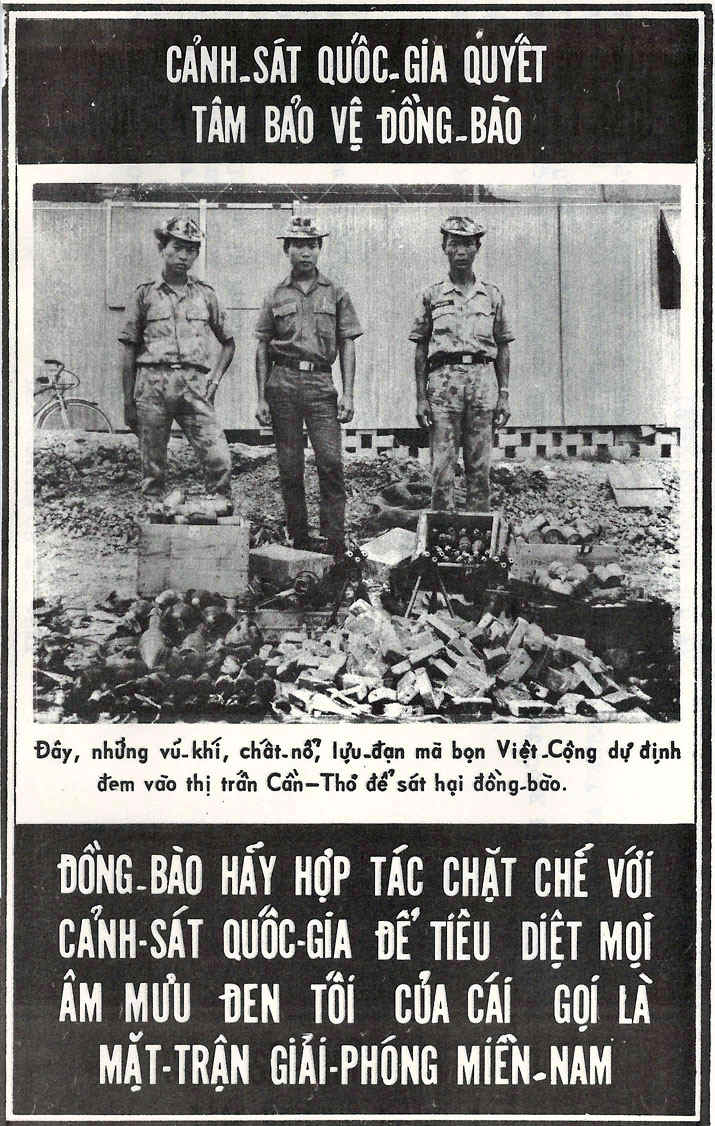
Leaflet 10-317-68
This leaflet was produced by the 10th PSYOP Battalion in June 1968 in support of
Vietnamese National Police operations. 200,000 leaflets were disseminated to the civilians
in the Phong Dinh Province on the subject of informing the police about enemy movement and
weapons. The front depicts police standing by a cache of enemy weapons. The text is:
The National Police are Determined to Protect People
Here, the weapons, explosives and hand grenades which the Viet Cong planned bringing
into Can Tho City to kill people are shown.
People should closely cooperate with the National Police to destroy any plot of the
so-called National Liberation Front.
The back is a very long all text propaganda message. I will translate a few lines:
By the people’s intelligence report of 9 May 1968, the Phong Dinh National
Police cooperated with friendly forces and launched a mopping-up operation…and
overran the Viet Cong’s base. In the operation, the Phong Dinh National Police forces
captured: 225 cakes of TNT explosives and detonators, 263 hand grenades, one B-41, one
AK-47, and large quantities of ammunition and documents.
If it wasn’t for the people’s cooperation, those weapons and ammunition
would have been used by the Viet Cong and the people would have greatly suffered….
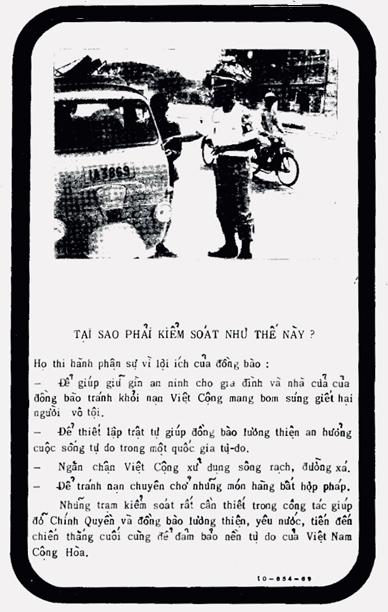
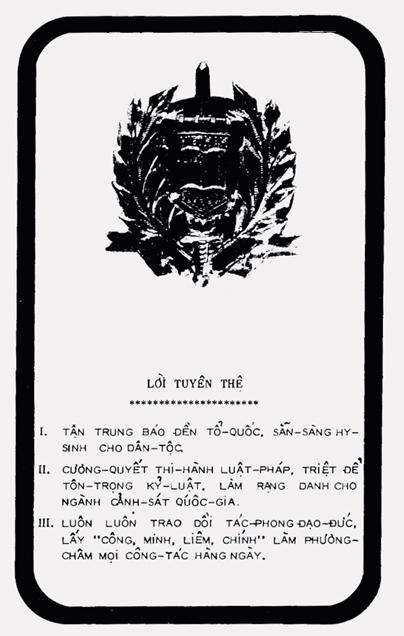
Paper Bag 10-054-69
20,000 copies of this paper bag were produced by the 10th PSYOP Battalion in August
1969 in support of Vietnamese National Police operations in IV Corps. In general, paper
bags did not work well in Vietnam because there was no tradition there of using them. The
text on the front is:
WHY IS THIS CHECK NECESSARY?
The National Police must make checks for your protection.
They help you maintain security for yourself and your family by preventing the Viet
Cong from carrying weapons and explosives into towns to kill innocent people.
They establish order in helping yon to live in a free nation.
They hinder the Viet Cong from using waterways and roads.
They eliminate the transportation of restricted materials and goods.
Checkpoints are necessary to carry out the task of helping the government and
patriots win a final victory which would assure the independence of Vietnam.
The back of the leaflet depicts a police badge and their oath of office:
NATIONAL POLICE OATH
Loyally serving our Country. Readily sacrificing oneself for the people.
Firmly enforcing the Law. Rigidly respecting discipline to brighten the image of the
National Police.
Always improving virtuous behavior, using impartiality, perspicacity, honesty and
uprightness for motivating daily tasks.
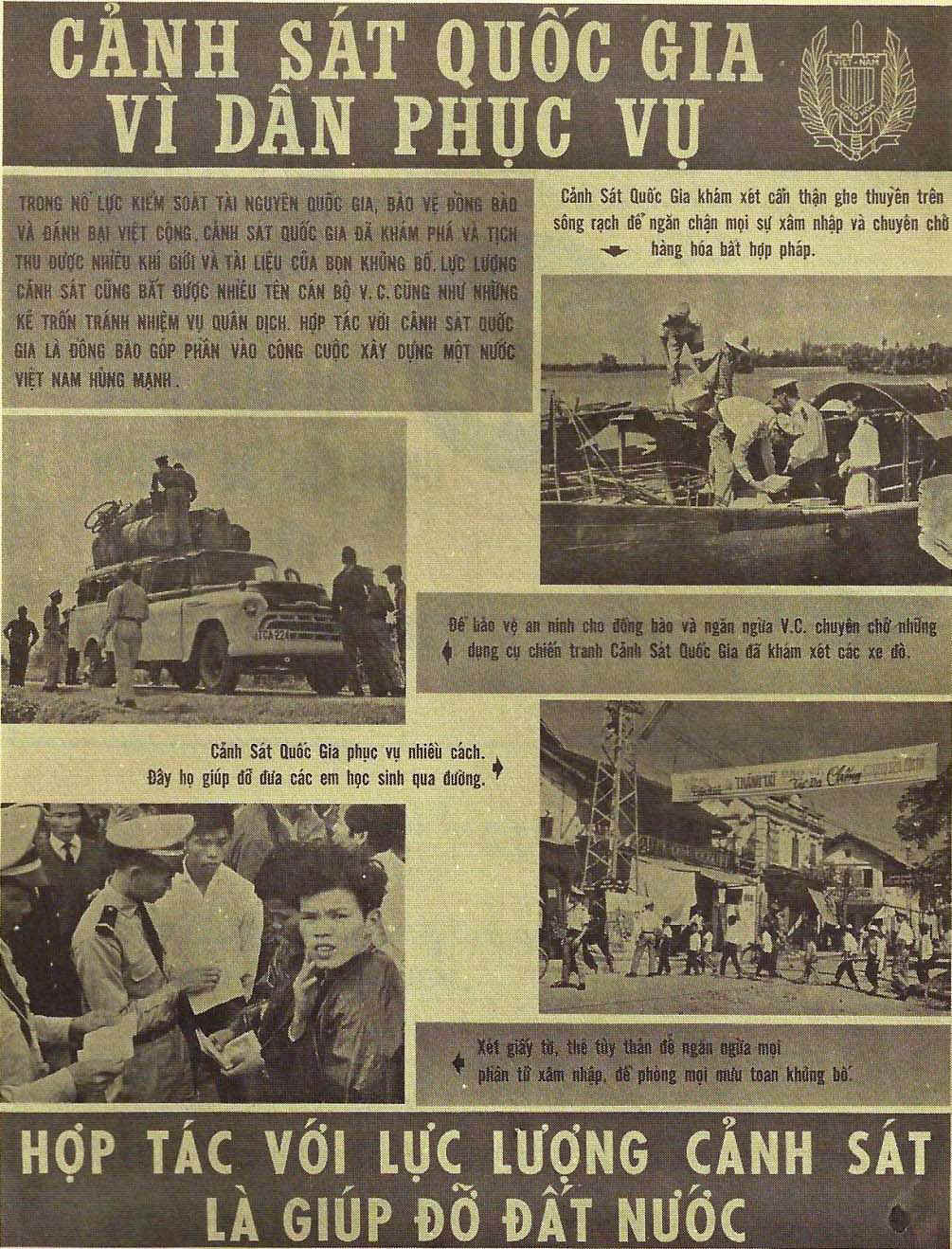
Poster 1655
This April 1967, 17 x 22-inch poster depicts the National Police performing various
duties. The text is:
NATIONAL POLICE SERVE THE PEOPLE
In their continuing efforts to control the national resources, protect the people,
and help defeat the Viet Cong, the National Police have seized many weapons and much war
material intended for terrorist activities. They also have captured many Viet Cong and
apprehended draft dodgers. If you want to help build a strong and free Vietnam, cooperate
with the National Police.
Another poster coded 2618 is entitled “The National Police Fight for the
People” and depicts scenes of the aftermath of the Tet attack of 1968.
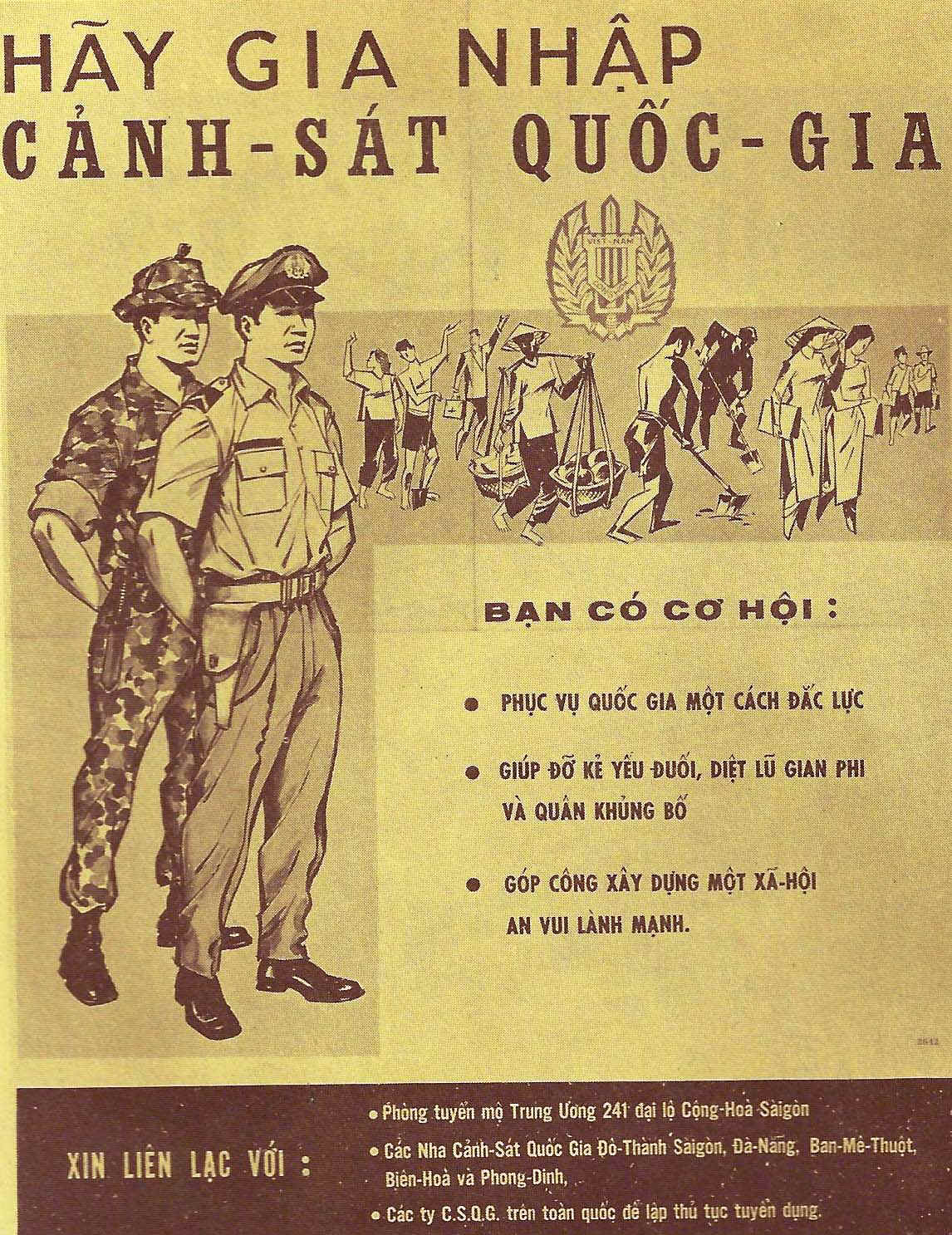
Poster 2642
This June 1968, 17 x 22-inch product is actually a recruiting poster for the police.
The text is:
JOIN THE NATIONAL POLICE
You will have the opportunity: to serve the nation effectively; to help the weak
people, to destroy the thieves and terrorists; to contribute to the building of a strong
and peaceful society…
Poster 1497 is also for recruitment and shows children crossing the street in a
peaceful Vietnam and the text in part:
To serve the people, serve with the police! Join now. Apply at your local police
station.
Recruitment poster 1513 was prepared in November 1968 and pictures a policeman on front
with a flag behind him. Some of the text is:
JOIN THE POLICE FORCE TO SHOW YOUR HIGH FIGHTING SPIRIT.
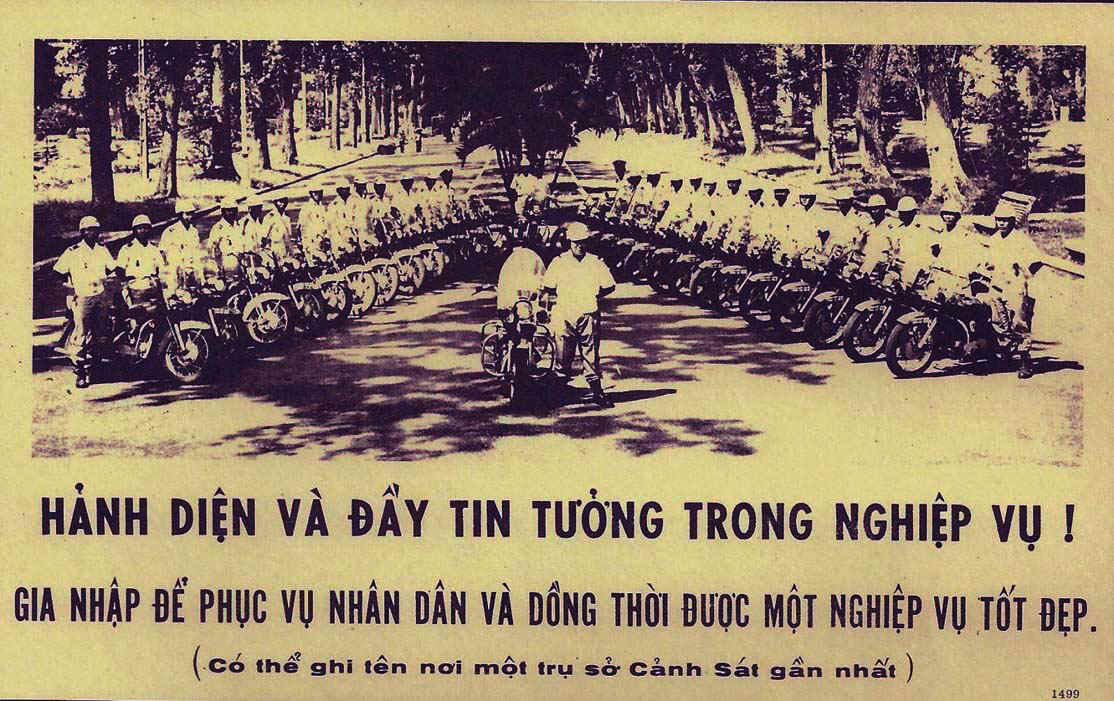
Poster 1499
Recruitment poster 1499 depicts a police motorcycle section and the text:
Proud of their position and confident in themselves! Join them. Serve the people.
Have a career.
Handout 3578 was prepared in December 1969 and depicts police doing various searches
from boats along the waterway. The text says in part:
When the river police call, compatriots must stop. Honest people have nothing to
fear. Don’t try to turn away or drift to the banks. Always carry necessary legal
papers and identity cards with you and show them to the river police when requested to do
so.
Poster 2618 dated June 1968 is 17 x 22-inches in size and depicts six photographs of
the National Police in action. The text is:
THE NATIONAL POLICE FIGHTS FOR THE PEOPLE
In destroying the Viet Cong infiltration units in the Capital and Province recently,
the National Police have shown its precious duty clearly: to help and protect people.
Poster 3117 was prepared in March of 1969 and asked the people to notify the National
Police if they saw anything suspicious:
Protect the lives of all who travel on the roads of your district.
Report all suspicious activities to the nearest National Police or official.
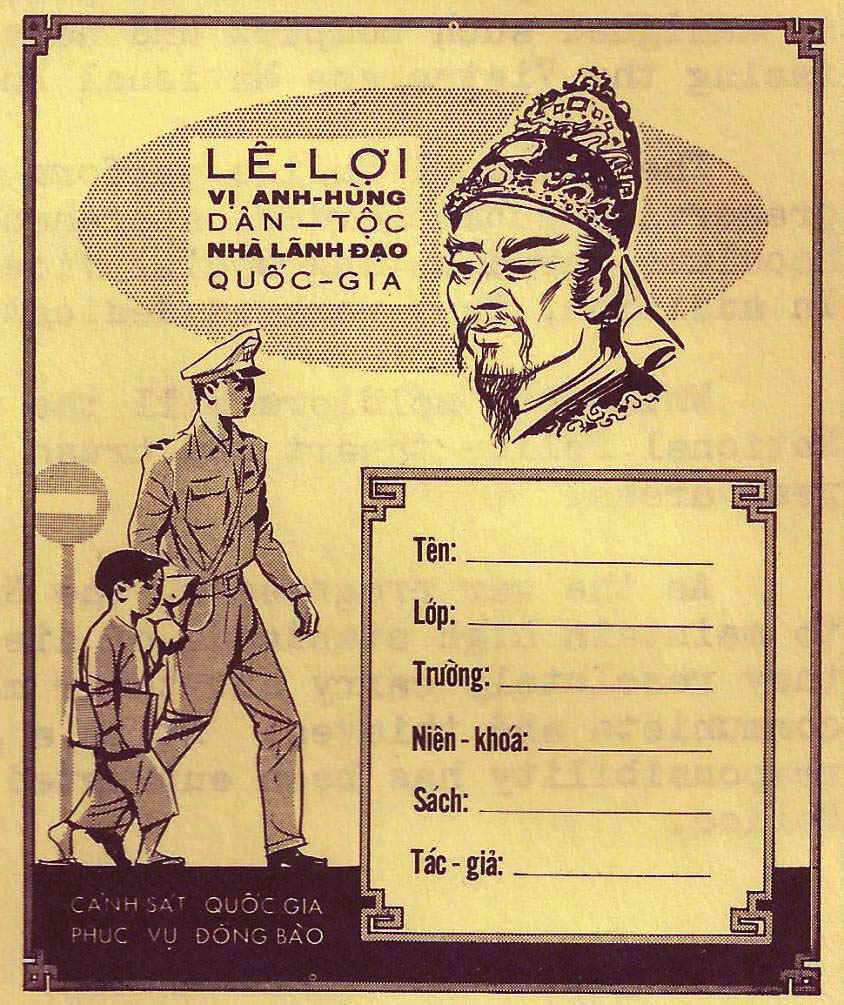
Book Cover 1762
It was not only leaflets that were used to influence the Vietnamese people. Here the
U.S. has printed an 11 x 9.5-inch book cover that children can carry to school and
constantly be reminded of their police force. The theme of this book cover is “The
National Police Serve the People.” This item was released in April 1967 and pictures
the Vietnam national hero Le Loi on the front. Le Loi was a Vietnamese general and emperor
who won back independence for Vietnam from China in 1428, founded the Later Le dynasty,
and became the most honored Vietnamese hero of the medieval period. Text on the front is:
LE LOI, THE NATIONAL HERO AND LEADER OF THE NATION
Name – Grade – School – School Year – Book –
Author
The text on the back of the book cover says in part:
At the present time, no police force in any other country is assigned such complex
and heavy responsibilities as those facing the Vietnamese National Police.
The National Police perform all normal duties such as: preserving public order,
apprehending lawbreakers and hoodlums, eradicating social vices, and helping the
unfortunate. In addition, they work as dedicated guardians of security.
While our soldiers kill the enemy on the battlefields, the National Police thwart
and crush enemy terrorist plots in rear areas…
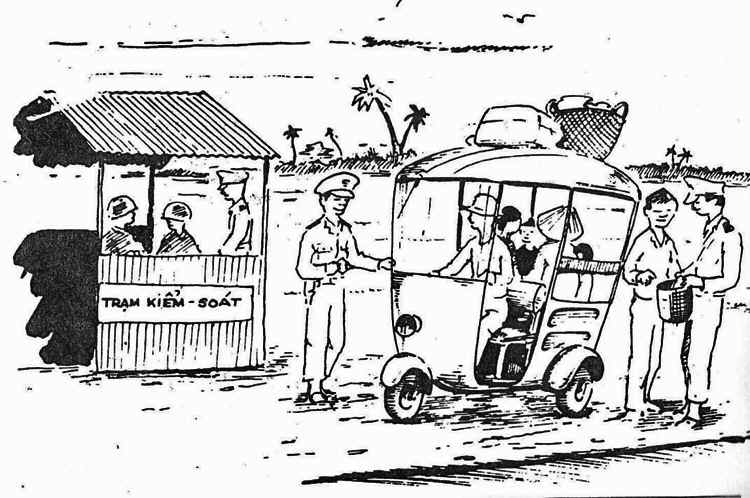
Leaflet 246-127
The leaflets above were all very professionally printed by the Joint U.S. Public
Affairs Office using the most modern printing techniques. Early in the war there were
small PSYOP companies supporting the combat units that printed much cruder leaflets as
requested. 100,000 copies of leaflet 245-127 were printed by the 246th PSYOP Company in
early 1966 in support of the National Police. It is basically just a line drawing of a
check point and Vietnamese civilians being inspected. It is very basic, but it does get
the message across. I should point out that the PSYOP company is right on the cusp of
printing better leaflets using photographs. I notice that the first photographic leaflet
is 246-148. The text on the back of 127 is:
Your government, its Allies and the National Police sincerely regret the
inconvenience caused at security checkpoints. In our struggle to maintain independence and
freedom, we must prevent supplies and information from reaching the Viet Cong. Please
accept the presence of government and Allied checkpoints as a sign of government concern
for the protection and welfare of you and your family. Just as we try to be of service to
you we hope that you will give us any information that might help us. We wish you a
peaceful and happy journey.

Leaflet 246-213
This is another very early 246th PSYOP
Company leaflet depicting Vietnamese civilians being inspected at a check
point.
One veteran wrote to point out that the “QC” on the
helmet in the leaflet stood for Quan Canh – South Vietnamese Army
Military Police. Everybody is smiling and happy, so apparently the stop is no
inconvenience to anyone. 50,000 of these leaflets were requested by the U.S.
1st Infantry Division. The text is:
Dear Travelers,
The government and its allies do not wish to disturb the people’s
communication and commerce with check points, but only to safeguard you and
your family from the Viet Cong aggressors. Just as we are trying to be of
service to you, we hope that you will give us any information that will help
us.

We do not wish to disturb the people
The above item mentions Disturb the People,
and this uncoded poster also uses something close to that statement. It
depicts the police checking a cart and the text:
We Do Not Want to Disturb the People
We Desire Only to Protect Public Security
This ends our very short look at the United States campaign to encourage the Vietnamese
people to respect and emulate their National Police. Readers who care to comment are
encourages to write to the author at sgmbert@hotmail.com.
End: June 2012

